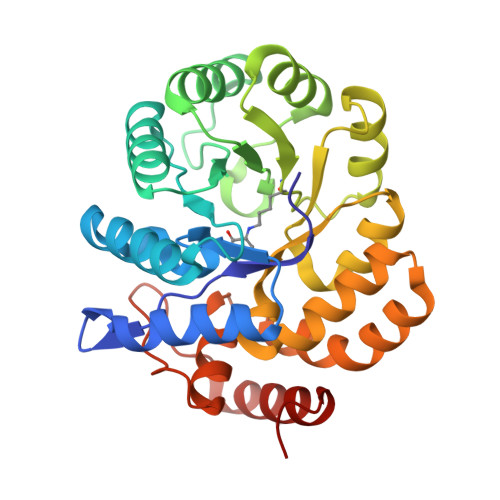Structural, functional and calorimetric investigation of MosA, a dihydrodipicolinate synthase from Sinorhizobium meliloti l5-30, does not support involvement in rhizopine biosynthesis.
Phenix, C.P., Nienaber, K., Tam, P.H., Delbaere, L.T., Palmer, D.R.(2008) Chembiochem 9: 1591-1602
- PubMed: 18536061
- DOI: https://doi.org/10.1002/cbic.200700569
- Primary Citation of Related Structures:
2VC6 - PubMed Abstract:
MosA is an enzyme from Sinorhizobium meliloti L5-30, a beneficial soil bacterium that forms a symbiotic relationship with leguminous plants. MosA was proposed to catalyze the conversion of scyllo-inosamine to 3-O-methyl-scyllo-inosamine (compounds known as rhizopines), despite the MosA sequence showing a strong resemblance to dihydrodipicolinate synthase (DHDPS) sequences rather than to methyltransferases. Our laboratory has already shown that MosA is an efficient catalyst of the DHDPS reaction. Here we report the structure of MosA, solved to 1.95 A resolution, which resembles previously reported DHDPS structures. In this structure Lys161 forms a Schiff base adduct with pyruvate, consistent with the DHDPS mechanism. We have synthesized both known rhizopines and investigated their ability to interact with MosA in the presence and absence of methyl donors. No MosA-catalyzed methyltransferase activity is observed in the presence of scyllo-inosamine and S-adenosylmethionine (SAM). 2-Oxobutyrate can form a Schiff base with MosA, acting as a competitive inhibitor of MosA-catalyzed dihydrodipicolinate synthesis. It can be trapped on the enzyme by reaction with sodium borohydride, but does not act as a methyl donor. The presence of rhizopines does not affect the kinetics of dihydrodipicolinate synthesis. Isothermal titration calorimetry (ITC) shows no apparent interaction of MosA with rhizopines and SAM. Similar experiments with pyruvate as titrant demonstrate that the reversible Schiff base formation is largely entropically driven. This is the first use of ITC to study Schiff base formation between an enzyme and its substrate.
- Department of Chemistry, University of Saskatchewan, 110 Science Place, Saskatoon, SK S7N5C9, Canada.
Organizational Affiliation:

















